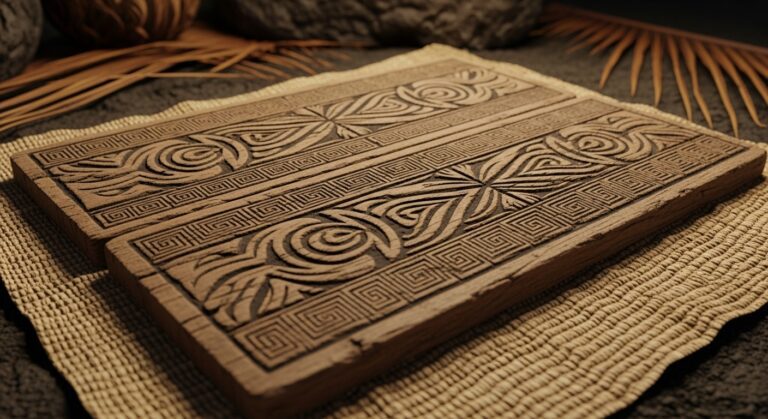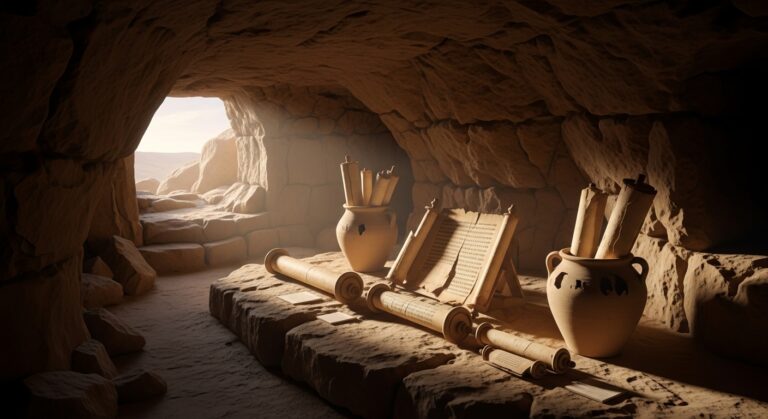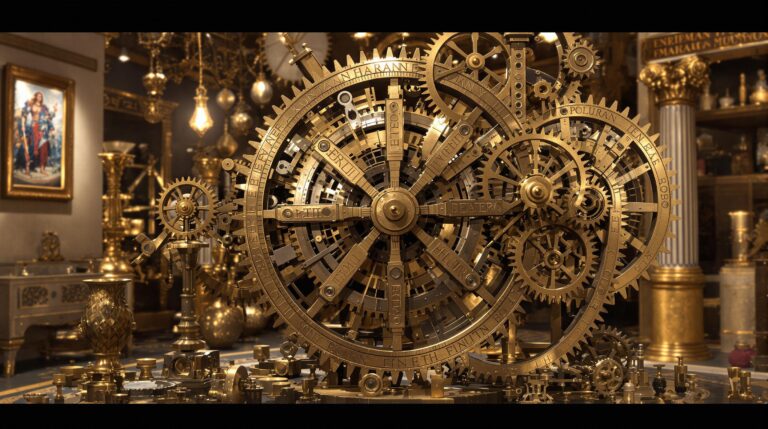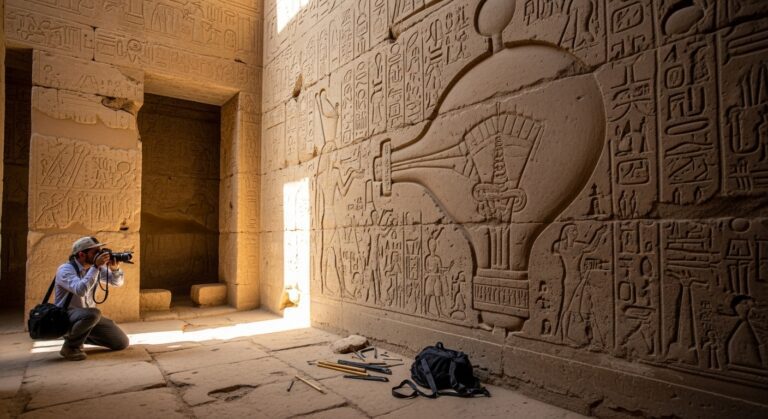Dropa Stones: Alien Artifacts?
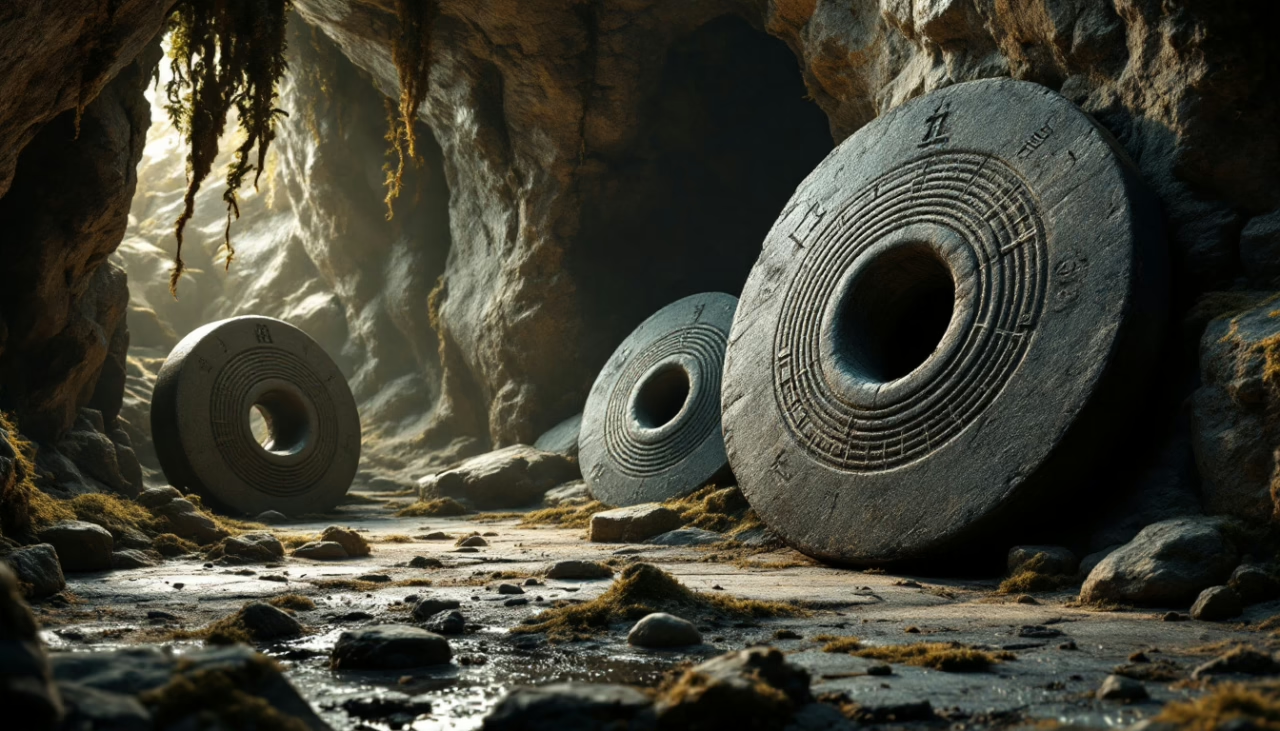
Dropa Stones: Mystery or Myth? – The Dropa stones stand at the crossroads of archaeological mystery and extraterrestrial speculation.
Discovered in 1938 among the rugged terrain of China’s Baian-Kara-Ula mountains, these disk-shaped artifacts bear spiral hieroglyphs that have confounded conventional interpretation.
Archaeological institutions remain skeptical, dismissing them as pseudoscientific fabrications, yet their persistent legend raises profound questions.
Could these stone disks, allegedly chronicling a crashed spacecraft, represent humanity’s first documented encounter with visitors from beyond our world?
Highlights
Hide- The Dropa stones are alleged artifacts with spiral hieroglyphs discovered alongside remains of small humanoids with large heads in Chinese caves.
- Proponents claim the stones' inscriptions tell of extraterrestrial visitors who crashed on Earth and became the Dropa people.
- No verified physical evidence of the Dropa stones exists in academic collections or scientific literature.
- Mainstream archaeologists consider the Dropa stones pseudoarchaeology lacking credible documentation or artifact verification.
- The stones' alleged disappearance and inaccessibility of discovery sites have fueled conspiracy theories about government cover-ups of alien contact.
Mysterious Discovery of Dropa Stones in the Baian-Kara-Ula Mountains
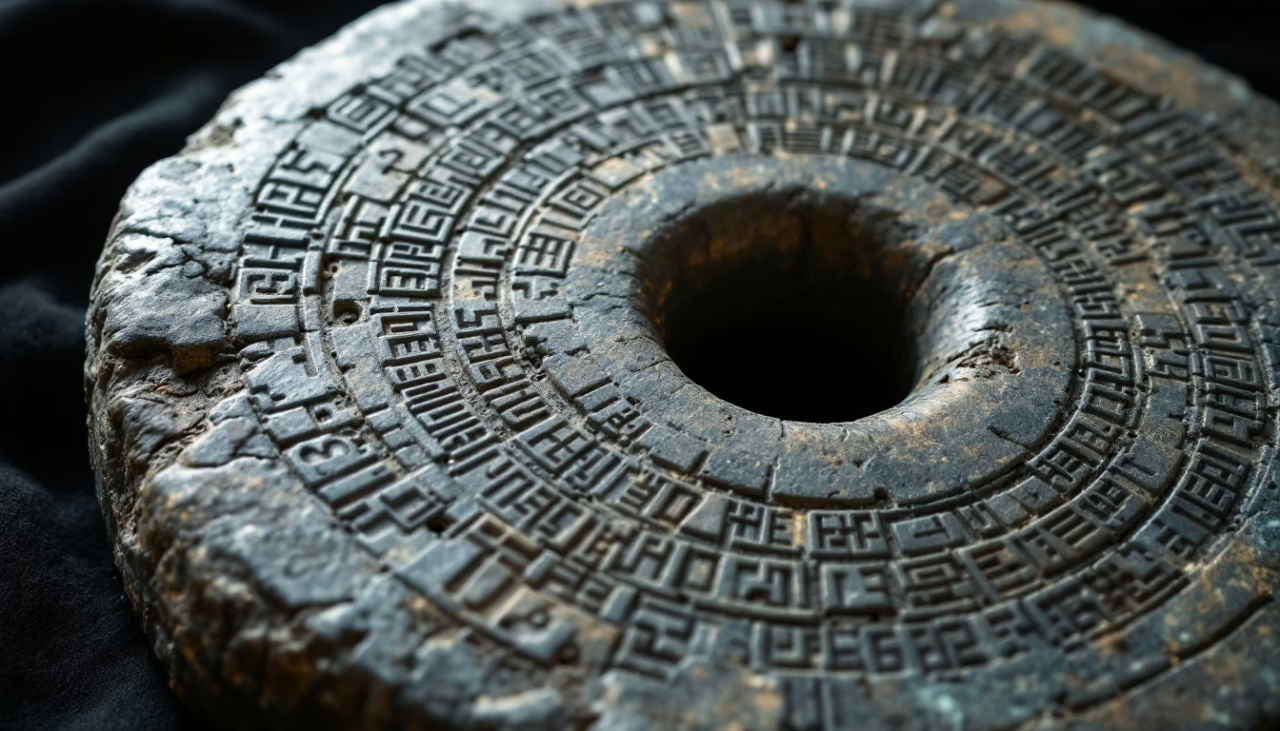
According to controversial accounts, archaeologist Chi Pu Tei allegedly discovered hundreds of stone discs during a 1938 expedition to China’s remote Baian-Kara-Ula mountains, where they were reportedly found in cave systems alongside small-statured skeletal remains.
The most intriguing feature of these purported artifacts, commonly known as “Dropa stones,” are their unusual inscriptions—concentric circles and unfamiliar characters that some fringe researchers claim represent an ancient writing system of non-terrestrial origin.
Though mainstream archaeology has largely dismissed these tales as fabrications without credible evidence, the persistence of the Dropa stone narrative illustrates humanity’s enduring fascination with unexplained artifacts and their potential to challenge conventional understandings of prehistoric contact.
Alleged 1938 Expedition and the Stone Discs
In 1938, Chinese archaeologist Chi Pu Tei allegedly led an expedition to the Baian-Kara-Ula mountains where his team discovered cave burial sites containing the skeletal remains of beings with disproportionately large heads alongside curious stone discs.
These enigmatic artifacts, approximately 12 inches in diameter with a central hole resembling phonograph records, exhibited spiral grooves that, upon closer examination, contained microscopic hieroglyphic markings unrelated to any known writing system.
The stone discs, reportedly 716 in number, were composed of a granite-like material containing high concentrations of cobalt and other metals, presenting a remarkable archaeological anomaly that would later fuel speculation about their extraterrestrial origins.
Claims of Chinese archaeologists uncovering cave burial sites
The mysterious saga of the Dropa Stones begins, as many archaeological legends do, with an expedition shrouded in historical ambiguity.
According to uncorroborated reports, Chinese archaeologists discovered peculiar cave burial sites containing skeletal remains of diminutive beings alongside stone discs.
These controversial findings, lacking substantial archaeological significance or scientific analysis, persist primarily through public perception rather than verifiable historical context.
Details about the discs: size, material, and unique carvings
Enigmatic artifacts from an alleged archaeological find, commonly referred to as the Dropa Stones, measure approximately 12 inches (30 centimeters) in diameter with a curious hole at their center, resembling oversized phonograph records from a bygone era.
The discs’ dimensions and material composition—reportedly granite-like with high cobalt content—showcase remarkable ancient craftsmanship through intricate spiral grooves and carvings, whose significance remains fiercely debated among alternative historians.
The Strange Inscriptions on the Stones
The Dropa stones, objects of enigmatic provenance, feature curious spiral grooves that bear an uncanny resemblance to phonograph records from a more recent era.
Upon closer examination, these spiraling indentations reveal intricate symbols that defy translation into any known human language, suggesting either an elaborate code or, as some researchers controversially propose, communication from a non-terrestrial origin.
The precise arrangement and consistent patterning of these markings have prompted decades of scrutiny from linguists and archaeologists alike, yet their meaning remains tantalizingly beyond contemporary decipherment methods.
Spiral grooves resembling phonograph records
Among the most intriguing features of the Dropa stones, discovered in the remote Baian-Kara-Ula mountain range, are the precisely crafted spiral grooves etched into their surfaces.
These spiral patterns bear remarkable phonograph similarities, prompting speculation about ancient technology potentially designed for extraterrestrial communication.
While mainstream archaeologists favor artistic interpretations, the mathematical precision of these grooves continues to challenge conventional historical narratives about prehistoric technological capabilities.
Symbols that suggest unknown language or code
Inscribed across the surface of each Dropa stone, mysterious hieroglyphic symbols form patterns that have confounded linguists and archaeologists since their discovery in 1938.
These cryptographic symbols bear no resemblance to known ancient scripts, presenting one of archaeology’s most perplexing puzzles.
The unknown linguistics challenge conventional theories of language origins, suggesting either an isolated cultural development or, as some controversially propose, non-terrestrial communication systems.
The Story of the Dropa People
According to contentious ancient manuscripts, the Dropa people were descendants of extraterrestrial beings who crash-landed in the remote Baian-Kara-Ula mountains thousands of years ago.
These alleged cosmic visitors, reportedly small in stature with oversized heads, were initially feared and persecuted by local tribes before establishing their isolated mountain community.
The narrative of these purported “sky people” remains one of archaeology’s most disputed legends, entangling legitimate anthropological questions about isolated human populations with controversial claims of prehistoric alien contact that continue to fascinate both fringe theorists and skeptical historians alike.
Supposed Ancient Records of Extraterrestrial Origin
According to controversial translations of the Dropa stones, these ancient discs allegedly chronicle the arrival of extraterrestrial beings who crash-landed in the Baian-Kara-Ula mountains thousands of years ago.
The narrative describes how these otherworldly visitors, unable to repair their spacecraft, were forced to adapt to Earth’s environment and eventually formed a tribe known as the Dropa people, distinguished by their diminutive stature and unusually large heads.
This fantastical account, embraced by ancient astronaut theorists yet dismissed by mainstream archaeologists, represents one of the most persistent claims of prehistoric alien contact, offering an alternative interpretation of isolated human populations that developed in China’s remote mountainous regions.
Interpretations of the translated discs
The translated content of the enigmatic Dropa stones presents a narrative so extraordinary that it challenges conventional archaeological understanding, weaving a tale of cosmic travelers who crash-landed on Earth millennia ago.
Various interpretation theories suggest these artifacts represent a convergence of alien linguistics and ancient human documentation, carrying profound cultural significance that reshapes our historical context and creates revolutionary archaeological implications.
Claims of a spaceship crash and survival of a non-human group
Central to the Dropa stones mythology stands a remarkable claim—that approximately 12,000 years ago, a spacecraft containing extraterrestrial beings crashed in the Baian-Kara-Ula mountains of China, leaving survivors who became stranded on Earth.
According to this narrative, these non-human entities established primitive dwellings, utilizing remnants of their alien technology while gradually integrating with ancient civilizations through extraterrestrial encounters that forever altered human history.
Who Were the Dropa?
According to disputed ancient texts, the Dropa were allegedly small-statured beings with enlarged heads who crash-landed on Earth thousands of years ago in what is now the China-Tibet border region.
Their physical characteristics, described as measuring approximately 4 feet tall with disproportionately large skulls, appear in some interpretations to resemble figures depicted in cave paintings discovered in the Baian Kara Ula mountains.
These supposed visual representations, featuring slender bodies with oversized cranial structures, have fueled speculation about connections between the purported extraterrestrial visitors and primitive artistic records of actual encounters, though mainstream archaeology has found no credible evidence supporting these claims.
Description of the alleged beings from ancient texts
Ancient manuscripts describe the Dropa as diminutive beings with delicate frames, standing barely over four feet tall, with disproportionately large heads and slender limbs unsuited for the harsh mountainous terrain they allegedly inhabited.
These physical descriptions have fueled extraterrestrial encounter theories, though cultural interpretations vary widely among scholars of ancient civilizations, who alternately view these accounts as alien folklore origins or metaphorical representations of isolated human tribes.
Physical depictions and connections to cave paintings
The cave paintings discovered throughout the Baian-Kara-Ula mountain range offer compelling visual evidence that complements textual descriptions of the Dropa people, revealing figures with distinctly non-human proportions etched into stone walls dating back approximately 12,000 years.
This prehistoric symbolism features elongated heads and diminutive frames, creating a visual storytelling tradition that alternative cultural interpretation connects to possible alien contact through cave art.
Skepticism and Academic Controversy
Despite the compelling narrative of the Dropa stones, the scientific community remains overwhelmingly skeptical due to a persistent lack of verifiable evidence and laboratory testing.
Archaeological authorities, including prominent sinologists and ancient artifact specialists, have categorically dismissed the alleged discovery as pseudoarchaeology, pointing to inconsistencies in the original accounts and the conspicuous absence of the artifacts in museum collections.
The controversy continues to exemplify the tension between speculative archaeology and academic rigor, with critics effectively demonstrating that the stones’ story contains hallmarks of folklore rather than archaeological fact.
Lack of Verifiable Evidence
Despite decades of discussion surrounding the alleged Dropa stones, the academic community remains justifiably skeptical due to a conspicuous absence of verifiable expedition records or peer-reviewed publications.
The artifacts, purportedly discovered in 1938 by Chinese archaeologist Chi Pu Tei, have never been independently examined by mainstream scientists, photographed with proper documentation, or housed in any recognized museum collection.
This troubling lack of physical evidence, combined with inconsistencies in the discovery narrative, suggests the Dropa stones may represent nothing more than an elaborate archaeological fiction that gained traction through repetition rather than substantiation.
Absence of credible expedition records or academic papers
Almost no credible expedition records or academic papers exist to substantiate the Dropa Stones’ alleged discovery, creating a problematic void in the narrative often overlooked by enthusiasts.
The absence of field notes, photographs, or published findings meeting archaeological standards prevents proper evidence verification, while established academic scrutiny has never validated these claims.
Historical narratives regarding the stones remain fractured and inconsistent, lacking expedition credibility required by scientific institutions.
Challenges in confirming the existence of the Dropa stones
Numerous attempts to verify the physical existence of the Dropa stones have encountered insurmountable obstacles, leaving researchers and skeptics alike in an epistemological quandary.
The challenges of evidence collection are compounded by concerns over archaeological integrity and pervasive cultural misconceptions.
Scientific skepticism remains robust in the absence of specimens meeting standards of historical accuracy that would satisfy academic scrutiny beyond reasonable doubt.
Critics and Debunkers
Prominent archaeologists and historians have universally dismissed the Dropa stones narrative as a fabrication lacking any substantiating evidence, classifying it alongside other pseudoarchaeological claims that misappropriate legitimate cultural artifacts.
The original story appears to have emerged from a 1960 article in a German vegetarian magazine, later embellished through repetition across various fringe publications without verification.
What remains particularly telling is that no mainstream scientific journal has ever documented these alleged discoveries, and Chinese academics—who would naturally have the most direct access to such artifacts if they existed—have consistently denied any knowledge of their existence.
Scholars labeling the account as a hoax
Scholars across multiple disciplines have systematically dismantled the Dropa stones narrative, labeling it one of archaeology’s most persistent hoaxes.
The evaluation of evidence within proper historical context reveals fatal inconsistencies that scholarly skepticism has repeatedly highlighted.
Academic integrity demands rigorous authentication protocols—standards the Dropa account consistently fails to meet.
Hoax theories dominate mainstream archaeological discourse whenever these alleged artifacts appear in pseudoscientific publications.
Discussion of likely sources of the original story
The genesis of the Dropa stones narrative can be traced to a 1960 article in the German magazine “Das vegetarische Universum,” where author Ernst Wegerer first introduced Western audiences to these purported alien artifacts.
Subsequent investigation revealed striking parallels to local folklore connections and cultural significance among indigenous populations, suggesting the story likely represents a creative fusion of ancient civilizations’ myths rather than archaeological authenticity, despite persistent extraterrestrial theories from enthusiasts.
Persistent Interest in the Unknown
Despite scientific dismissals, the Dropa stones continue to occupy a central position in modern UFO literature and ancient astronaut theories, demonstrating the enduring human fascination with potential extraterrestrial influences on our past.
These controversial artifacts, regardless of their authenticity, serve as powerful cultural symbols in a broader ecosystem of pseudoscientific narratives that attempt to explain historical mysteries through cosmic interventions.
The persistent appeal of such theories reveals a significant tension in contemporary society: the desire for wonder and mystery in an increasingly mapped and explained world, where the unknown represents not simply a gap in knowledge but a canvas for imagination.
Role in Modern Ufology and Pseudoscience
The enigmatic Dropa stones, despite their contentious origins, have solidified their place as enduring fixtures in modern ufology narratives and extraterrestrial artifact theories.
Their allure has permeated popular culture, appearing in countless speculative books, documentary series, and digital forums where enthusiasts dissect every facet of their alleged otherworldly significance.
This persistent fascination reflects humanity’s eternal quest for evidence of cosmic visitors, transforming these disputed objects into powerful symbols that transcend mere archaeological curiosities to become touchstones in our collective imagination about what might lie beyond Earth’s boundaries.
How the stones became a staple of alien theory narratives
Since capturing the imagination of pseudoarchaeological enthusiasts in the 1960s, the Dropa stones have evolved from obscure curiosities into canonical pillars of ancient alien theory narratives worldwide.
These artifacts gained prominence through media influence, becoming symbolic touchstones in cultural narratives that challenge archaeological skepticism about extraterrestrial theories.
Modern proponents cite them as definitive evidence of prehistoric alien contact with ancient civilizations.
Appearance in books, documentaries, and online forums
Books, documentaries, and online forums dedicated to alternative archaeology have propelled the Dropa stones from niche curiosities into mainstream pseudoscientific discourse since the late 1970s.
The cultural impact of these controversial artifacts persists through:
- Book references in “Chariots of the Gods” and similar alternative history texts
- Documentary analysis on fringe science channels
- Online debates across countless UFO forums
- Artifact theories perpetuated through social media sharing
Cultural Fascination with Ancient Alien Theories
The enduring allure of unexplained artifacts like the Dropa Stones illustrates humanity’s persistent fascination with potential evidence of ancient extraterrestrial contact.
Similar controversies surround numerous archaeological enigmas worldwide, from Peru’s vast Nazca Lines etched into desert plains to the supposedly anomalous geographical knowledge displayed in the 16th-century Piri Reis Map.
These cultural phenomena reveal not merely pseudoscientific curiosity but deeper existential questions about human origins and our cosmic significance, reflecting a collective yearning to discover connections between terrestrial history and the infinite mysteries of the universe.
Public appetite for unexplained artifacts
Despite rigorous scientific standards that govern academic archaeology, public fascination with unexplained artifacts and ancient alien theories continues to flourish across diverse cultural landscapes.
This artifact fascination transcends education levels and national boundaries, driven by:
- Public intrigue with cultural myths that challenge orthodox history
- Media amplification of unexplained phenomena
- The allure of conspiracy theories offering alternative narratives
- Human psychological need for mystery in an increasingly explained world
Similar cases: Nazca Lines, Piri Reis Map, and more
While the Dropa Stones continue to captivate fringe archaeology enthusiasts, they represent merely one strand in a complex tapestry of alleged alien artifacts and mysterious ancient formations that persist in popular imagination.
The Nazca Lines of Peru, Piri Reis map’s Antarctic coastline, megalithic structures like Sacsayhuamán, and other controversial cultural artifacts constitute the cornerstone evidence cited by Ancient Aliens theorists worldwide.
Alternative Theories and Interpretations
Beyond extraterrestrial interpretations lie alternative explanations for the Dropa stones that merit serious scholarly consideration.
Some archaeologists propose these artifacts are simply natural formations, misidentified cultural objects, or ritual items with symbolic rather than literal inscriptions.
The possibility that the entire narrative stemmed from mistranslation or deliberate fabrication—perhaps originating in mid-twentieth century speculative publications—represents a vital counterpoint to the more sensational alien hypothesis.
Possibility of Natural or Cultural Artifacts
The Dropa stones bear striking similarities to other megalithic artifacts across Asia, particularly ceremonial discs found in Nepalese and Tibetan religious contexts, suggesting possible cultural rather than extraterrestrial origins.
Archaeological comparisons reveal these disc-shaped objects may have served as sophisticated astronomical tools, with their circular patterns potentially representing celestial movements or seasonal calendars important to ancient communities.
These alternative interpretations, grounded in established anthropological frameworks, offer a compelling counternarrative to alien-origin theories while still acknowledging the remarkable craftsmanship and mystery that continue to surround these unusual artifacts.
Comparisons to other megalithic relics in Asia
Megalithic relics scattered across Asia’s diverse landscapes offer compelling comparative material for understanding the controversial Dropa stones within their broader archaeological context.
When examining historical context and archaeological significance, four key megalithic traditions stand out:
- The Gobekli Tepe complex in Turkey
- Dolmens of Korea’s southern regions
- Japan’s Yonaguni underwater formations
- Vietnam’s Plain of Jars monuments
Cultural symbolism within these ancient civilizations suggests non-extraterrestrial origins for megalithic structures.
Alternative uses: astronomical tools, ceremonial discs
When examining the Dropa stones through non-extraterrestrial perspectives, scholars have proposed several alternative explanations that situate these artifacts within established human cultural and technological frameworks.
The discs may have served as astronomical tools for tracking celestial bodies and seasonal alignments, similar to ancient observatories worldwide.
Alternatively, they could represent ceremonial objects used in cultural rituals or spiritual practices, their concentric patterns embodying cosmological significance rather than alien communication.
The Discs as a Fabrication or Mistranslation
The Dropa stones narrative exemplifies how archaeological misunderstandings can transform into elaborate extraterrestrial myths through decades of retelling and embellishment.
Media outlets, particularly those specializing in paranormal content, have amplified these claims without rigorous verification, converting what was likely a mistranslation of Chinese archaeological reports into “evidence” of ancient alien contact.
What began as potential stone burial artifacts discovered in 1938 has evolved through sensationalist reporting into intricately grooved discs allegedly containing alien histories, demonstrating the powerful allure of the extraordinary over the mundane explanation.
How urban legends evolve from misunderstood findings
Despite decades of fascination with the alleged Dropa stones, careful examination of how this legend evolved reveals a textbook case of archaeological misinterpretation transformed through cultural transmission into a persistent modern myth.
The evolution of such artifact mystique typically follows four stages:
- Initial misunderstood findings
- Embellishment through folklore evolution
- Mass media amplification of cultural narratives
- Entrenchment as urban legends despite contradictory evidence
Role of media and sensationalism
Media sensationalism surrounding the Dropa stones demonstrates how fringe archaeological claims can rapidly transform into “alternative history” through uncritical repetition and embellishment.
The public perception of these artifacts has been shaped more by media influence than scientific evidence, creating a cultural impact where sensationalist narratives consistently overshadow the sober examination of myth vs. fact in archaeological discourse.
Where Are the Dropa Stones Now?
The whereabouts of the controversial Dropa stones have become as enigmatic as their purported extraterrestrial origins, with numerous accounts suggesting the artifacts mysteriously vanished from museum collections or were deliberately suppressed by authorities unwilling to acknowledge their implications.
Physical evidence of these disk-shaped relics remains frustratingly elusive, compelling researchers and enthusiasts to undertake persistent quests through remote Chinese provinces and obscure academic archives for tangible proof of their existence.
The absence of verifiable specimens has only intensified speculation about governmental concealment, creating a vacuum where scientific verification should exist and transforming the Dropa stones into archaeological phantoms that hover tantalizingly beyond the grasp of contemporary examination.
Reports of Disappearance and Suppression
The alleged Dropa stones, once housed in museums across China, have significantly vanished from public view, sparking theories about institutional concealment.
Rumors persist of government intervention—Chinese officials allegedly confiscating artifacts deemed problematic for established historical narratives, sealing them away in classified archives beyond scholarly access.
These disappearances mirror similar patterns with controversial archaeological finds worldwide, where objects challenging conventional understanding often become entangled in bureaucratic limbo, their existence neither confirmed nor denied by authorities who perhaps prefer certain historical questions remain unanswered.
Claims of the artifacts vanishing from museums
Mysterious disappearances shroud the Dropa stones in an additional layer of intrigue, with numerous reports suggesting these controversial artifacts have vanished from public collections under suspicious circumstances.
Several institutions allegedly once housing these artifacts report:
- Complete removal from exhibition catalogs
- Missing specimen documentation
- Denial of ever possessing the items
- Official statements attributing absence to “routine collection management”
This pattern raises questions about museum disappearances and historical accountability.
Rumors of government interference or hidden archives
Following the mysterious museum disappearances, rumors of governmental involvement in the suppression of Dropa stone research have circulated persistently among alternative historians and conspiracy theorists alike.
These claims often reference classified documents allegedly containing analysis of the artifacts, hidden archives housing the actual stones, and systematic information suppression orchestrated by intelligence agencies concerned about potential evidence of ancient extraterrestrial contact.
Hunt for Physical Proof
Despite decades of intrigue surrounding the Dropa stones, numerous expeditions to the Baian-Kara-Ula mountains have failed to produce tangible evidence of their existence.
Modern researchers, equipped with advanced technology and archaeological expertise, continue to search remote caves and valleys of western China, hoping to uncover these alleged artifacts that could potentially rewrite human history.
The hunt for physical proof remains hampered by geographical isolation, Chinese governmental restrictions, and the troubling possibility that, if the stones ever existed at all, they have been deliberately hidden or destroyed to prevent scientific scrutiny.
Expeditions and individuals still searching for the stones
Since the purported disappearance of the Dropa stones from museum collections in the late 1970s, numerous expeditions and independent researchers have launched ambitious quests to relocate these controversial artifacts.
The archaeological significance of these searches stems from four primary motivations:
- Verification of extraterrestrial contact theories
- Documentation of ancient metallurgical capabilities
- Preservation of potential historical evidence
- Resolution of decades-long academic debates surrounding their authenticity
Challenges in verifying their location or existence
The hunt for physical proof of the Dropa stones represents one of archaeology’s most persistent and frustrating puzzles.
Verification methods have been hampered by inconsistent historical narratives and questionable archaeological integrity. Researchers struggle to establish proper cultural context for artifacts that seem to vanish whenever scrutiny intensifies.
Evidence analysis becomes impossible when the primary subjects remain elusive, scattered across private collections or potentially lost to time.
Wrapping Up
The Dropa stones remain an enduring enigma at the crossroads of archaeology, mythology, and extraterrestrial speculation.
Despite academic skepticism and limited physical evidence, these disk-shaped artifacts continue to captivate those who ponder humanity’s cosmic connections.
Could these ancient objects truly represent a forgotten chapter of interstellar contact?
Whether genuine artifacts or elaborate hoaxes, the stones illuminate humanity’s persistent quest to find meaning and connection in the mysterious vestiges of our past.


